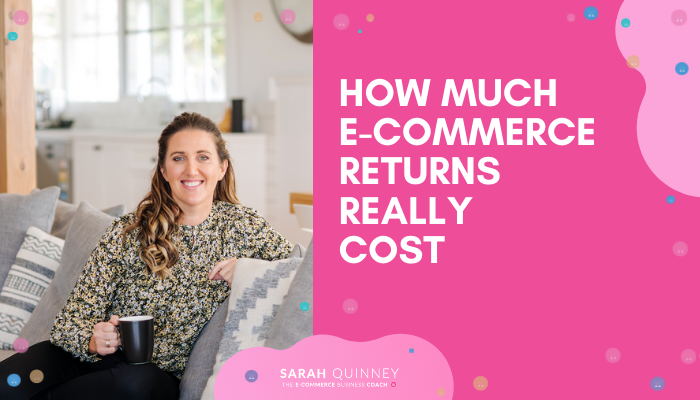
How Much E-Commerce Returns Really Cost
Online stores make it easy and convenient for customers to satisfy all of their shopping needs. But sometimes, customers don’t receive what they were expecting. Other times, they decide they’re no longer interested. What do these have in common? They both result in E-Commerce returns.
Every E-Commerce company has experienced processing returns; it’s far more common than some may assume. Did you know that E-Commerce return rates hover around 30%? Contrary to a brick-and-mortar return rate that hovers around 9%, 3 in 10 seems quite high. Luckily, there are ways to lower this number for your store. It all starts with understanding why returns happen and how you can learn from them.
Reasons for E-Commerce Returns
To an online seller, a return isn’t just a return. Returns hold hidden costs that the average customer likely does not realize.
- False understanding of product/wrong size
- Shipping damage
- No longer interested
- Order mistakes
Customers return online purchases for a multitude of reasons. Online and in-store shopping are very different. In-person browsing allows customers to feel, touch, and really see items they’re interested in, all of which are stripped away when shopping virtually. The lack of physical interaction can create a false understanding of the product’s qualities.
Take clothing for example. Clothing is a commonly returned item type. The inability to try something on before purchasing unsurprisingly leads to a higher return rate. An in-store purchase allowing try-ons is automatically less likely to result in a return.
Shipping damage is another common cause of returns. Most successful E-Commerce stores have effective shipping practices, but things happen. Once a package is shipped, it’s out of your hands as the seller. It can be tossed around, dropped, or handled roughly.
Unfortunately, this can result in damaged items. As the seller, you should ensure that breakable items are packaged accordingly, and consider working with a shipping company that has a good track record in this department.
Sometimes, the buyer simply changes their mind. This happens commonly and doesn’t mean there was anything wrong on the seller’s end.
Lastly, we’re all human. None of us are perfect, and shipping mistakes happen. The fourth common form of returns comes from seller error, i.e. shipping the wrong item or sending out an incorrect size.
The Cost of an E-Commerce Return
E-Commerce returns create a loss in revenue in more than one way.
The first and most obvious is the revenue lost from the sale of the item. Unless an exchange takes place, the seller loses money on the sale.
Offer free return shipping? That money is now lost. Though free return shipping can be a fabulous perk for shoppers (79% of customers want it), it comes at a price for the seller.
A third way that money is lost is through ad spending. If money was spent on an ad that prompted the sale, this money is now lost.
Finally, a return has the potential to cause future revenue loss by severing a customer relationship. Though a return does not always translate to a lost customer, each instance creates the possibility. Aim to provide top-tier service and handle returns with grace to prevent lost customers.
Why Use a Return Policy?
It is estimated that nearly two-thirds of consumers will check out a company’s return policy before officially making their purchase. What’s interesting is that it actually prompts sales! When a shopper is confident that they can make a return if needed, they’re more likely to follow through with the purchase.
It is very important to include a clear return policy on your website. It should candidly state the criteria needed to make a return (i.e. tags must be attached, the item must be unused, etc.) and the timeframe in which returns are permitted. Including this information not only outlines the process to customers but also covers you from holding liability. Consider including an exchange policy as well.
If you’re considering skipping the return policy (which is not recommended), be sure to check the guidelines for your state before doing so. Some states require that a policy be conspicuously displayed in order to protect shoppers. Other states defer to the discretion of the company itself.
What to Look for in Returns
E-Commerce returns are learning experiences. It pays to pay attention to returns and look at why they were made.
For example, if there is a high volume of an item being returned, is there a reason?
Perhaps a faulty part or quality issue is to blame. For a clothing item, perhaps the sizing is off and new measurements are required. Maybe there’s an issue with the manufacturing process that can be addressed.
Honing in on the cause of the trend could help your store’s quality assurance stay in check while also reducing future returns. Consider upgrading manufacturing, shipping, or any other step in order to create the best shopping experience possible.
Note: Take quality assurance one step further by sending out post-purchase surveys. This can be done via email or SMS message and should ask customers to rate their experience. Consider responses and uncover ways to improve your business if applicable.
Handling E-Commerce Returns
Unfortunately, people aren’t always honest. Many E-Commerce store owners have experienced a dishonest return, such as an incorrect or damaged item that is sent back. If this happens, based on your policies you may have the right as the seller to deny a refund. This is why a solid E-Commerce return policy is imperative — it covers you from liability.
Companies don’t generally enjoy seeing returns, but a lot can be learned during the process. Consider returns to be a positive experience that helps your business improve and create more efficient and effective systems.
—

Ready to scale your online store?
The E-Commerce Women In Business Mastermind – your exclusive e-commerce coaching and e-commerce digital marketing mentorship for women looking to Grow and Scale your online store. Click here to learn more
Yours in success,
Sarah x
